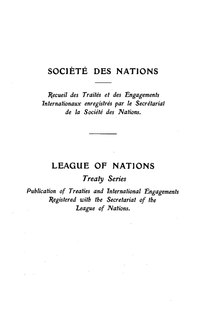Conference for the Reduction and Limitation of Armaments
Aimed towards a global reduction in arms, the conference was organised and campaigned for by the League of Nations with the main objective to avoid another world war.During the course of the war, technology surrounding weaponry development and new types of arms emerged: specifically, a focus on not only land equipment and personal but also the navy and the air force,[2] which Borg described as having "considerable weight and influence".[5] It included all the Allies that had signed the Treaty of Versailles with Germany[9] and all neutral countries such as Switzerland that had vested interests in disarmament in Europe specifically.[9] The Geneva Conference was convened by the League of Nations in 1932 to fulfil the terms of Article 8 and to progress towards world peace by the process of disarmament.The conference convened on the 1 February 1932 in Geneva, Switzerland, with the intention of implementing strategies to fulfill Article 8 of the Covenant of the League of Nations.The conference began to attempt to enact the goals of the League of Nations,[11] which primarily involved classifying classes of weaponry and fortifications.Sir Basil Liddell Hart, a British military historian who was known largely for his strategy surrounding mechanical warfare,[13] was present at the conference.[12] In addition, other discussions were brought up during the General Commission such as whether the agreements were still in place during wartime, whether other regulatory bodies should be established to monitor and to enforce it and whether there should be demilitarised zones.Those issues were agreed upon with the ideal that the agreements set about should apply to both wartime and peacetime, a nonpolitical body should monitor disarmament and there should be no specific demilitarised zones.[14] As argued by Marlies ter Borg, the proposal that Hoover presented to the conference on the 22 June 1932 was a "potential turning point"[12] by suggesting that the US would abolish all aircraft, submarines, military aviation, tanks, poison gas and one third of the battleships.[17] As soon as Hitler rose to power, he began the process of rearming Germany, clearly defying both the Treaty of Versailles and the objective of the Disarmament Conference.Stimson realised that Germany's position in European affairs could not be ignored, as it had been at Geneva in 1927 or at London in 1930, but he did not know how to reconcile German military ambition with French fear of its neighbour.However, most academic sources and historians blame a combination of the rise of Hitler, the consequent withdrawal of Germany from the conference, the general unwillingness of nations to disarm, the highly-unstable political and economic climate and the looming threat of another world war.



Arthur HendersonGenevaSwitzerlanddisarmamentCovenant of the League of NationsLeague of NationsUnited StatesFirst World WarSecond World WarNazi GermanyEuropetotal warTreaty of VersaillesHague ConferencesArticle 231 of the Treaty of Versailleswar guilt of Germanyarms raceBritish Foreign SecretaryFranklin Rooseveltsecond major European conflictUnited KingdomFranceGermanyHugh S. GibsonLondon ConferenceBasil Liddell Hartmechanical warfareWinston ChurchillfortificationsBaltic SeaNorth SeaHerbert HooverMarlies ter BorgUS CongressCzechoslovakiaPolandJoseph StalinSoviet Famineinterwar periodSoviet ArmyVyacheslav MolotovManchuriaMukden IncidentAdolf Hitlerrearming GermanyHenry L. StimsonManchurian crisisUS Navyaircraft carriersFar EastLibrary of CongressParis Peace Conference (1919–1920)MembersOrganisationMinority TreatiesLittle Treaty of VersaillesMandates"War guilt" clauseReparationsReparation CommissionDawes PlanHague conference on reparationsYoung PlanLausanne ConferenceLocarnoStresa FrontPossible cause of the Second World WarInternational Opium ConventionTreaty of Saint-Germain-en-LayeTreaty of Neuilly-sur-SeineTreaty of TrianonTreaty of SèvresPartition of the Ottoman EmpireConference of London (1920)San Remo conferenceTurkish National MovementTurkish War of IndependenceTreaty of LausanneBig FourAmerican Commission to Negotiate PeaceCommission of ResponsibilitiesThe InquiryList of participantsA Peace Conference at the Quai d'OrsayThe Signing of Peace in the Hall of MirrorsTo the Unknown British Soldier in FranceWashington Treaty (1922)Geneva Conference (1927)London Treaty (1930)Anglo-German Agreement (1935)London Treaty (1936)